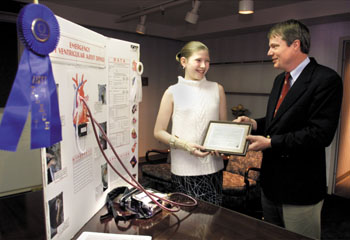
Kaylah Brown, 12, a student at MLK High Magnet School, receives an award for her LVAD science project from Dr. Richard Pierson, a cardiac and thoracic surgeon at Vanderbilt. Kaylah won second place in the Vanderbilt University-sponsored statewide science fair. (photo by Dana Johnson)
Student takes state prize for heart pump
One student measured how far a golf ball traveled for a recent science competition. But Kaylah Brown set off to build a project a little closer to heart. She built a heart pump for kids, with a little help from Vanderbilt University Medical Center’s heart transplant team.
Kaylah, a 12-year-old seventh grader at Martin Luther King Jr. Magnet High School, won a bevy of prizes for her recent science project. Although judges deemed the golf ball experiment more worthy of first prize in the Metro-wide science fair, Kaylah’s technology took first place at her school, third place in Metro and second at a recent statewide competition.
This was her third year to compete. In fifth grade she tested cleaning agents to see which worked best. Last year, she tackled the ability to learn in different environments – watching TV or in quiet.
She got the idea for this year’s project while watching a TV news program about left-ventricular assist devices, heart pumps used as a bridge to heart transplant. “They said there were no pumps for kids,” Kaylah remembered.
A friend in need also helped inspire her. “I have a friend in El Salvador, and when they had the (January 13) earthquake, I thought if anyone needed a heart pump they would,” she said. She decided to make a temporary LVAD for children, one that could be used in emergencies until the child arrived at a hospital.
With the idea, Kaylah sought technical assistance. She e-mailed a couple of transplant programs that install LVADs. She got cold responses, until she e-mailed Vanderbilt transplant coordinator Renee Howser. Vanderbilt has installed 26 implantable LVADS in patients waiting for a transplant.
“Kaylah is a very bright, enthusiastic, and determined young lady,” Howser said. “For an initial try at the device, and never seeing a real one work before, she is on the right track. It is definitely portable enough for smaller patients.”
Kaylah gathered materials: a 12-amp battery from Radio Shack, a Grainger 5-liter pump and clear tubing. Howser helped her determine and simulate the specific gravity of blood – a specification requirement for the project – with corn starch, water and red food dye.
With all the pieces in place and the data closely recorded, Kaylah turned on her project and watched the blood-like liquid circulate.
The best part of the project, she said, “is knowing I could make one.”













